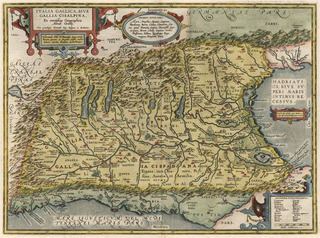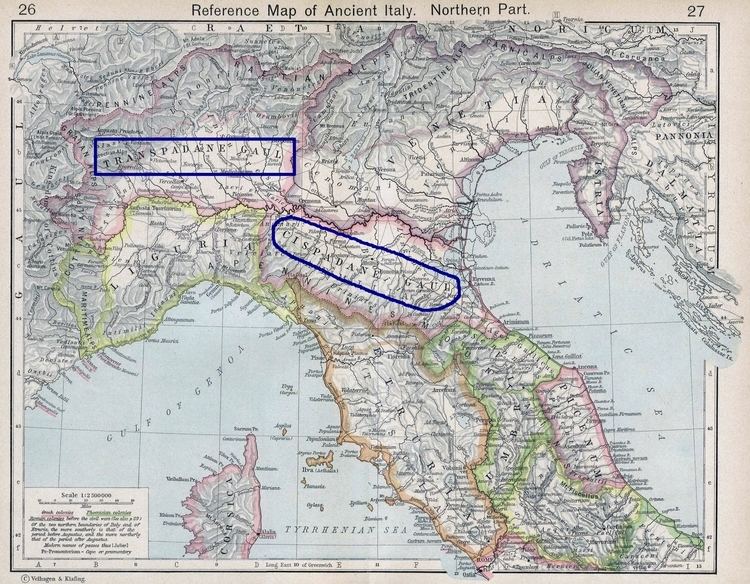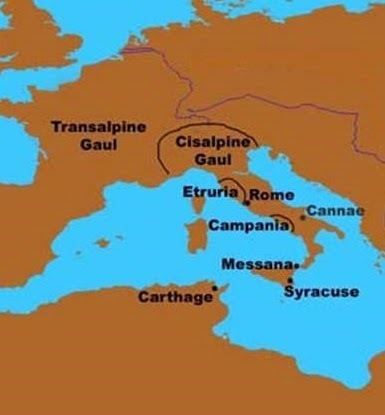 | ||
0 a d cisalpine gaul
Cisalpine Gaul (Gallia Cisalpina), also called Gallia Citerior or Gallia Togata, was the part of Italy inhabited by Celts (Gauls) during the 4th and 3rd centuries BC. Conquered by the Roman Republic in the 220s BC, it was a Roman province from c. 81 BC until 42 BC, when it was merged into Roman Italy. Until that time, it was considered part of Gaul, precisely that part of Gaul on the "hither side of the Alps" (from the perspective of the Romans), as opposed to Transalpine Gaul ("on the far side of the Alps").
Contents
- 0 a d cisalpine gaul
- Cisalpine gaul northern italy
- Early history
- Gallic expansion and Roman conquest
- Roman province
- The Canegrate culture
- Golasecca culture
- Language
- References

Gallia Cisalpina was further subdivided into Gallia Cispadana and Gallia Transpadana, i.e. its portions south and north of the Po River, respectively. The Roman province of the 1st century BC was bounded on the north and west by the Alps, in the south as far as Placentia by the river Po, and then by the Apennines and the river Rubicon, and in the east by the Adriatic Sea. In 49 BC all inhabitants of Cisalpine Gaul received Roman citizenship, and eventually the province was divided among four of the eleven regions of Italy: Regio VIII Gallia Cispadana, Regio IX Liguria, Regio X Venetia et Histria and Regio XI Gallia Transpadana.

Cisalpine gaul northern italy
Early history

The Canegrate culture (13th century BC) may represent the first migratory wave of the proto-Celtic population from the northwest part of the Alps that, through the Alpine passes, penetrated and settled in the western Po valley between Lake Maggiore and Lake Como (Scamozzina culture). They brought a new funerary practice—cremation—which supplanted inhumation. It has also been proposed that a more ancient proto-Celtic presence can be traced back to the beginning of the Middle Bronze Age (XVI-XV century BC), when North Western Italy appears closely linked regarding the production of bronze artifacts, including ornaments, to the western groups of the Tumulus culture (Central Europe, 1600 BC - 1200 BC). The bearers of the Canegrate culture maintained its homogeneity for only a century, after which it melded with the Ligurian aboriginal populations and with this union gave rise to a new phase called the Golasecca culture, which is nowadays identified with the Celtic Lepontii. Livy (v. 34) has the Insubres, led by Bellovesus, arrive in northern Italy during the reign of Tarquinius Priscus (7th-6th century BC), occupying the area between Milan and Cremona. Milan (Mediolanum) itself is presumably a Gaulish foundation of the early 6th century BC, its name having a Celtic etymology of "[city] in the middle of the [Padanic] plain". Polybius in the 2nd century BC wrote about co-existence of the Celts in northern Italy with Etruscan nations in the period before the Sack of Rome in 390 BC.

Ligures lived in Northern Mediterranean Coast straddling South-east French and North-west Italian coasts, including parts of Tuscany, Elba island and Corsica. Ligurian tribes were also present in Latium (see Rutuli) and in Samnium. According to Plutarch they called themselves Ambrones, which could indicate a relationship with the Ambrones of northern Europe. Little is known of the Ligurian language. Only place-names and personal names remain. It appears to be an Indo-European branch with both Italic and particularly strong Celtic affinities. Because of the strong Celtic influences on their language and culture, they were known in antiquity as Celto-Ligurians (in Greek Κελτολίγυες, Keltolígues). Modern linguists, like Xavier Delamarre argues that Ligurian was a Celtic language, similar to, but not the same as Gaulish. The Ligurian-Celtic question is also discussed by Barruol (1999). Ancient Ligurian is either listed as Celtic (epigraphic), or Para-Celtic (onomastic).
The Veneti were an Indo-European people who inhabited north-eastern Italy, in an area corresponding to the modern-day region of the Veneto. By the 4th century BC the Veneti had been so Celticized that Polybius wrote that the Veneti of the 2nd century BC were identical to the Gauls except for language. The Greek historian Strabo (64 BC–AD 24), on the other hand, conjectured that the Adriatic Veneti were descendant from Celts who in turn were related to later Celtic tribe of the same name who lived on the Belgian coast and fought against Julius Caesar. He further suggested that the identification of the Adriatic Veneti with the Paphlagonian Enetoi led by Antenor — which he attributes to Sophocles (496–406 BC) — was a mistake due to the similarity of the names.
Gallic expansion and Roman conquest
In 391 BC, Celts "who had their homes beyond the Alps, streamed through the passes in great strength and seized the territory that lay between the Appennine mountains and the Alps" according to Diodorus Siculus. The Roman army was routed in the battle of Allia, and Rome was sacked in 390 BC by the Senones.
The defeat of the combined Samnite, Celtic and Etruscan alliance by the Romans in the Third Samnite War ending in 290 BC sounded the beginning of the end of the Celtic domination in mainland Europe. At the Battle of Telamon in 225 BC, a large Celtic army was trapped between two Roman forces and crushed.
In the Second Punic War, the Boii and Insubres allied themselves with the Carthaginians, laying siege to Mutina (Modena). In response, Rome sent an expedition led by L. Manlius Vulso. Vulso's army was ambushed twice, and the Senate sent Scipio with an additional force to provide support. These were the Roman forces encountered by Hannibal after his crossing of the Alps. The Romans were defeated in the Battle of the Ticinus, leading to all the Gauls except for the Cenomani to join the insurgency. Rome then sent the army of Tiberius Sempronius Longus who engaged Hannibal in the Battle of the Trebia, also resulting in a Roman defeat, forcing Rome to temporarily abandon Gallia Cisalpina altogether, returning only after the defeat of Carthage in 202 BC. Rome conquered the last remaining independent Celtic kingdom in Italy in 192 BC.
Roman province
Sometimes referred to as Gallia Citerior ("Hither Gaul"), Provincia Ariminum, or Gallia Togata ("Toga-wearing Gaul", indicating the region's early Romanization). Gallia Transpadana denoted that part of Cisalpine Gaul between the Padus (now the Po River) and the Alps, while Gallia Cispadana was the part to the south of the river.
Probably officially established around 81 BC, the province was governed from Mutina (modern-day Modena), where, in 73 BC, forces under Spartacus defeated the legion of Gaius Cassius Longinus, the provincial governor.
In 49 BC, with the Lex Roscia, Julius Caesar granted to the populations of the province the full Roman citizenship.
The Rubicon River marked its southern boundary with Italia proper. By crossing this river in 49 BC with his battle-hardened legions, returning from the conquest of Gaul, Julius Caesar precipitated the civil war within the Roman Republic which led, eventually, to the establishment of the Roman Empire. To this day the term "crossing the Rubicon" means, figuratively, "reaching the point of no return".
The province was merged into Italia about 42 BC, as part of Octavian's "Italicization" program during the Second Triumvirate. The dissolution of the provincia required a new governing law or lex, although its contemporary title is unknown. The parts of it inscribed on a bronze tablet preserved in the museum at Parma are entirely concerned with arranging the judiciary: the law appoints two viri and four viri juri dicundo, and also mentions a Prefect of Mutina.
Virgil, Catullus and Livy, three famous sons of the province, were born in Gallia Cisalpina.
The Canegrate culture
The Canegrate culture reflects a late Bronze Age to early Iron Age culture in the Pianura Padana. These areas are now known as western Lombardy, eastern Piedmont and Canton Ticino.
The Canegrate culture testifies to the arrival of a first "proto-Celtic" migratory wave of populations from the northwest part of the Alps that, crossing the alpine passes, had not yet infiltrated and settled down in the western Po area between Lake Maggiore and the Lake of Como. They were bearers of a new funerary practice, which supplanted the old culture of inhumation instead introducing cremation.
The population of Canegrate maintained its own homogeneity for a limited period of time, approximately a century, after which they blended with the Ligurian aboriginal populations to create a new culture called the Golasecca culture.
Golasecca culture
The Culture of Golasecca (9th to 4th centuries BC) spread between the end of the Bronze Age and the beginning of the Iron Age in the areas of northwestern Lombardy and Piedmont, and the Canton Ticino [3]. At the end of the prehistoric period, this was an area where travelers frequently stopped and had contact with the Hallstatt culture to the west, the Urnfield culture to the north and with the Villanova culture to the south. The Golasecca culture was initially concentrated in the foothills area south of the Alps. It later spread throughout the lakes area, and established many settlements representing this original culture. The oldest remains found thus far can be dated from the 9th century BC.
Language
There is some debate whether the Lepontic language should be considered as a Gaulish dialect or an independent branch within Continental Celtic. Apart from Lepontic, the "Cisalpine Gaulish language" proper would be the Gaulish language as spoken by the Gauls invading northern Italy in the 4th century BC. This is a dialect of the larger Gaulish language, with some known phonetic features distinguishing it from Transalpine dialects, such as -nn- replacing -nd- and s(s) replacing -χs-.
